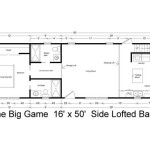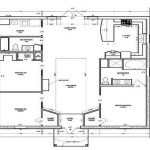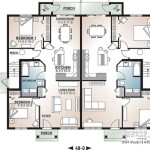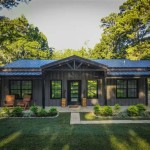Open Floor Plan: Maximizing Space in Small Houses
The concept of an open floor plan, characterized by minimal interior walls and a seamless flow between living spaces, has gained significant popularity in modern residential architecture. While often associated with sprawling estates and loft apartments, its application in small houses presents a unique set of advantages and challenges. This article will explore the benefits and considerations of implementing an open floor plan in a smaller living space, analyzing how this design approach can contribute to functionality, aesthetics, and overall livability.
The Allure of Openness in Confined Spaces
In small houses, space is a premium and design choices must be carefully considered to optimize every square foot. An open floor plan addresses this constraint by eliminating unnecessary walls that traditionally divide the living room, dining area, and kitchen. This removal of visual barriers creates an immediate sense of spaciousness, making the house feel larger and more airy than its actual dimensions might suggest. The uninterrupted sightlines also enhance natural light penetration, as light can filter more freely throughout the entire area, reducing the need for artificial illumination and creating a brighter, more welcoming environment.
Beyond the spatial advantages, an open floor plan fosters a sense of connection among occupants. Without physical barriers, family members can interact more easily, even while engaged in different activities. A parent preparing dinner in the kitchen can still converse with children playing in the living room, and conversations can flow seamlessly during gatherings of friends and family. This enhanced social interaction is a key benefit for those who value a sense of community and shared living experiences within the home.
Furthermore, an open floor plan offers a greater degree of flexibility in furniture arrangement and space utilization. The absence of fixed walls allows for a more dynamic and adaptable layout, enabling homeowners to reconfigure the space according to their changing needs and preferences. A dining table can be moved to accommodate a larger group, or a living area can be converted into a temporary workspace. This adaptability is particularly valuable in small houses, where every square foot must serve multiple purposes.
The open concept design can also add resale value to a home. This style is a desirable feature for many potential buyers, making a smaller open concept home more attractive on the market. The updated and modern feel can be a selling point.
Practical Considerations and Potential Drawbacks
While the advantages of an open floor plan in a small house are compelling, it is crucial to acknowledge the practical considerations and potential drawbacks that must be addressed during the design and implementation phases. One primary concern is the lack of defined zones and privacy. Without walls to delineate distinct areas, sound and visual elements can easily travel throughout the open space, potentially leading to distractions and a lack of personal space. Noise from the kitchen might disrupt activities in the living room, and visual clutter can become overwhelming in the absence of designated storage areas.
To mitigate these challenges, careful planning and strategic design interventions are essential. Zoning can be achieved through various means, such as strategically placed furniture, area rugs, changes in flooring material, or variations in ceiling height. These subtle cues can help to visually separate different functions within the open space without compromising the overall sense of openness. For example, a large area rug can define the boundaries of the living room, while a kitchen island can serve as a physical and visual barrier between the cooking area and the dining space.
Effective sound management is also crucial in an open floor plan. Soft furnishings, such as upholstered furniture, curtains, and rugs, can help to absorb sound and reduce echoes. Consider using sound-dampening materials in the construction of walls and ceilings, particularly in areas where noise transmission is a concern, such as near bedrooms or bathrooms. These strategies can help create a more acoustically comfortable and private environment, even within an open space.
Adequate storage is paramount in small houses, and an open floor plan requires careful attention to storage solutions. Integrated storage units, built-in shelving, and multi-functional furniture can help to maximize space and minimize clutter. Consider incorporating storage into unconventional areas, such as under stairs or along hallways. A well-designed storage system can help to maintain a sense of order and organization, preventing the open space from feeling cramped and chaotic.
Another consideration is the potential for odors to travel throughout the open space. Cooking smells can easily permeate the entire house, which may be undesirable for some occupants. To address this, invest in a high-quality range hood with effective ventilation to remove cooking odors and grease from the air. Additionally, consider using air fresheners or essential oil diffusers to maintain a pleasant ambient scent. Regular cleaning and maintenance can also help to prevent lingering odors.
Heating and cooling can also present a challenge in an open floor plan. Because the space is not divided into separate rooms, it can be more difficult to regulate the temperature in specific areas. Consider using a zoned heating and cooling system to provide individual temperature control for different zones within the open space. Ceiling fans can also help to circulate air and distribute temperature more evenly. Insulating the walls and ceilings properly throughout the home can also aid in energy conservation.
Design Strategies for Optimizing Open Concept Living
Successfully implementing an open floor plan in a small house requires a strategic approach to design, focusing on maximizing space, creating distinct zones, and addressing practical considerations. One key strategy is to choose furniture that is appropriately scaled for the space. Overly large or bulky furniture can overwhelm the open area and make it feel cramped. Opt for smaller-scale pieces with clean lines and minimalist designs. Multi-functional furniture, such as sofa beds or storage ottomans, can also help to maximize space and provide additional storage.
Color palettes play a crucial role in creating a sense of spaciousness in an open floor plan. Light, neutral colors, such as whites, creams, and grays, can reflect light and make the space feel larger and more airy. Incorporating pops of color through accessories, artwork, or accent walls can add visual interest and personality without overwhelming the space. Avoid using dark or heavily patterned colors, as these can make the space feel smaller and more enclosed. Utilizing similar color schemes throughout the open areas, encourages a visual flow from one area to the next.
Lighting is another important element in an open floor plan. A combination of natural and artificial light can create a warm and inviting atmosphere. Maximize natural light by using large windows and skylights. Supplement natural light with a variety of artificial light sources, such as recessed lighting, pendant lights, and floor lamps. Layering the lighting can create different moods and highlight specific areas within the open space. Adding dimmers to light fixtures that allow for adaptable lighting based on activity.
Maintaining a consistent design aesthetic throughout the open space is crucial for creating a cohesive and harmonious look. Choose a style that resonates with the homeowner's taste and stick to it throughout the different areas. This can be achieved by using similar materials, colors, and furniture styles. A consistent design aesthetic will help to tie the different areas together and create a sense of unity.
Vertical space should also be considered in the design. Tall shelving units, floor-to-ceiling curtains, and high-mounted artwork can draw the eye upward and make the space feel taller. This can be particularly effective in small houses with low ceilings. Utilizing this space efficiently can create the illusion of more space.
Ultimately, the success of an open floor plan in a small house depends on careful planning, thoughtful design, and a commitment to maintaining a sense of order and organization. By addressing the practical considerations and implementing effective design strategies, homeowners can create a living space that is both functional and aesthetically pleasing, maximizing the potential of their small home.

10 Small House Plans With Open Floor Blog Homeplans Com

10 Small House Plans With Open Floor Blog Homeplans Com

Pros And Cons Of Open Concept Floor Plans

3 Small Open Layout Decor Tips And 23 Ideas Digsdigs

10 Small House Plans With Open Floor Blog Homeplans Com

4 Simple Ways To Stage An Open Floor Plan No Vacancy Atlanta

Pin Page

Family Home With Small Interiors And Open Floor Plan Bunch Interior Design Ideas

Modern Farm House Style Plan 6846 Northwest 619

Small Cottage House Plans With Modern Open Layouts Houseplans Blog Com








